Analytical Study on Amgen Inc. - Environmental and Market Analysis
VerifiedAdded on 2022/08/19
|5
|864
|16
Report
AI Summary
This report presents an analytical study of Amgen Inc., examining its adherence to environmental regulations, safety and health standards, and risk management practices. The study investigates Amgen's compliance with U.S. regulatory agencies like the EPA and FDA, emphasizing its commitment to EHS. It also analyzes the company's strategies for achieving a competitive advantage and expanding market share, including understanding competitors, knowing customer needs, differentiation, marketing, improving customer service, and targeting new markets. The report highlights the importance of EHS risk assessment and provides insights into Amgen's proactive approaches to risk management, including compliance, environmental, safety, climate, and change management risks. It also includes a review of strategies for gaining market share.
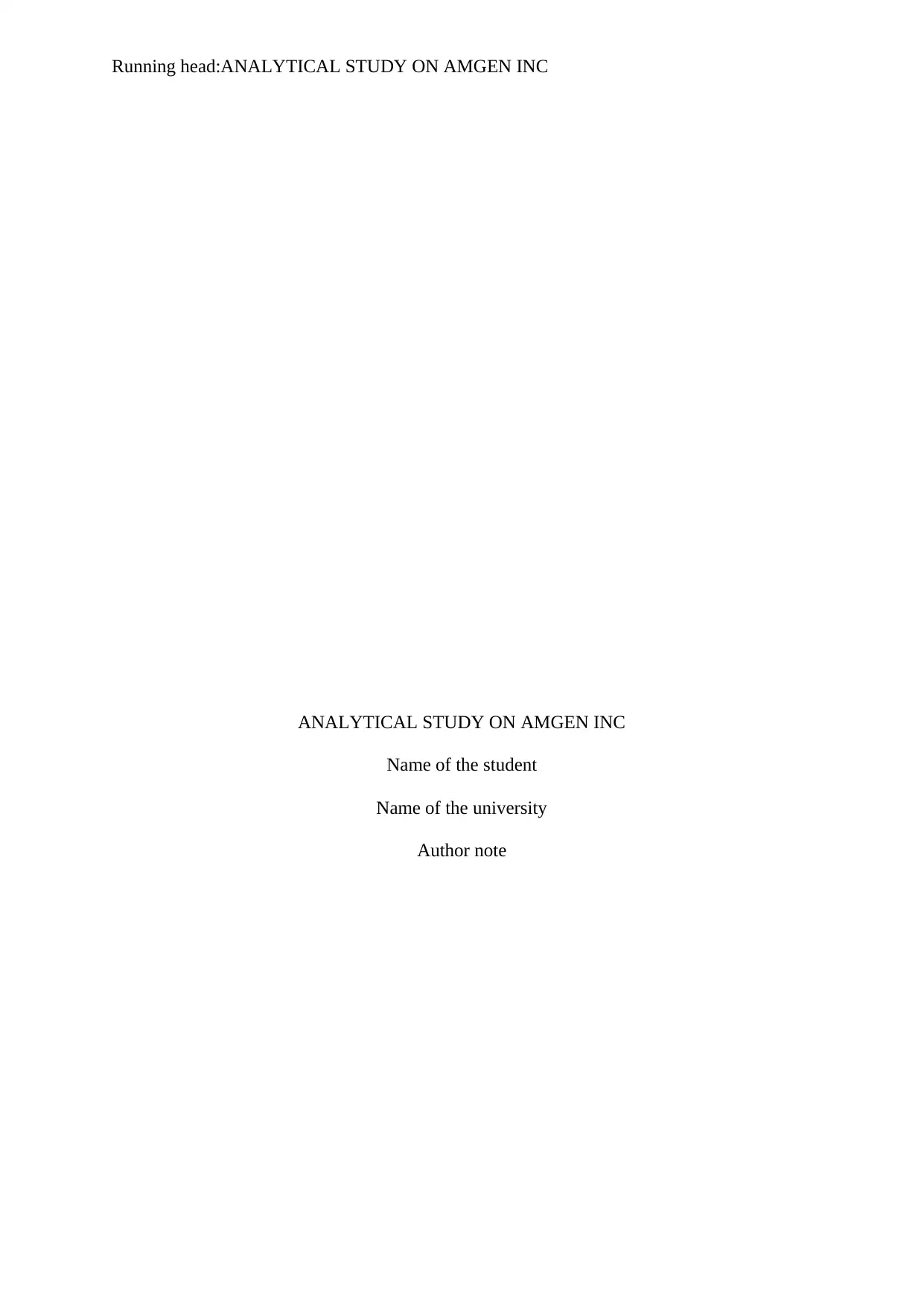
Running head:ANALYTICAL STUDY ON AMGEN INC
ANALYTICAL STUDY ON AMGEN INC
Name of the student
Name of the university
Author note
ANALYTICAL STUDY ON AMGEN INC
Name of the student
Name of the university
Author note
Paraphrase This Document
Need a fresh take? Get an instant paraphrase of this document with our AI Paraphraser
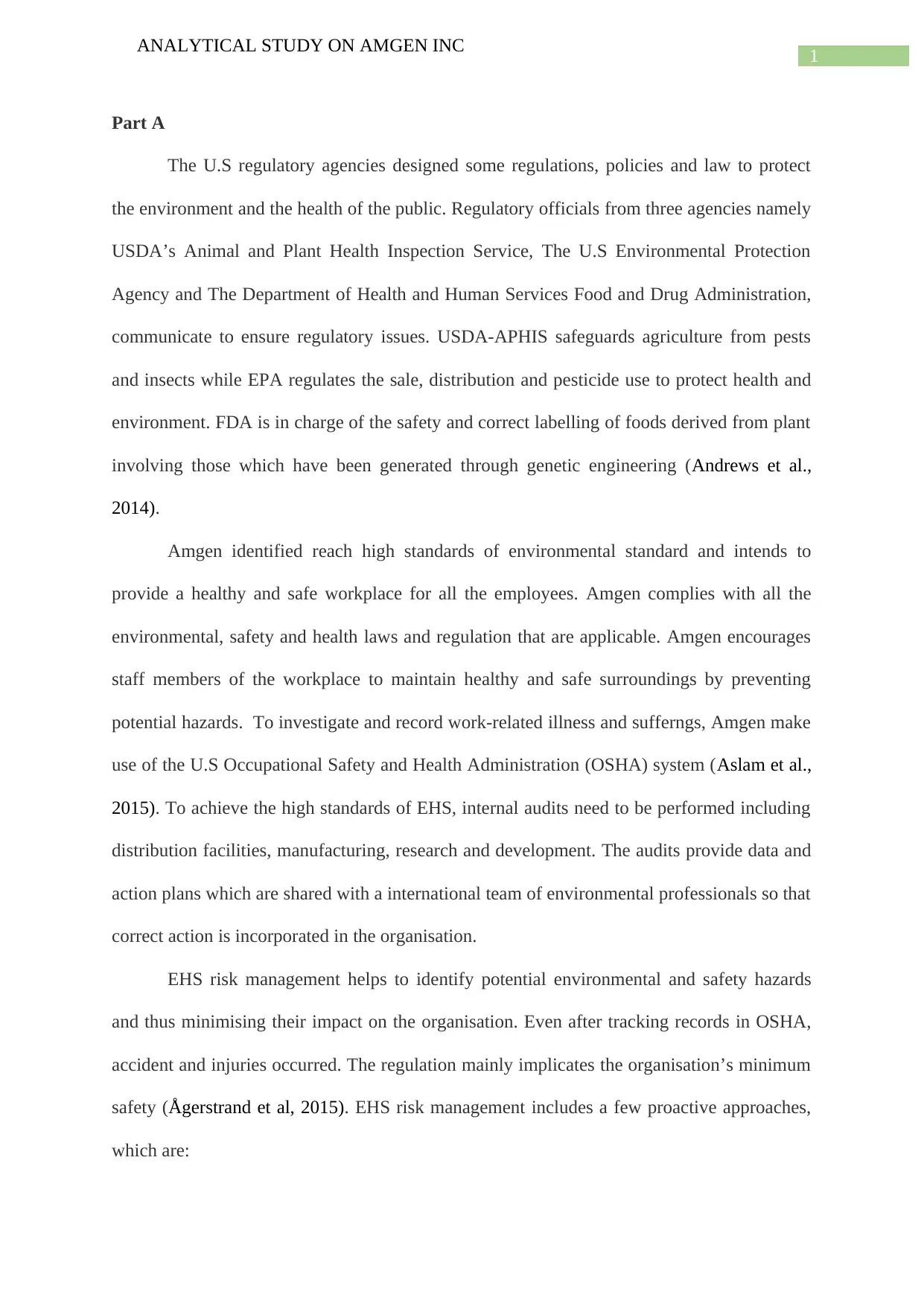
1
ANALYTICAL STUDY ON AMGEN INC
Part A
The U.S regulatory agencies designed some regulations, policies and law to protect
the environment and the health of the public. Regulatory officials from three agencies namely
USDA’s Animal and Plant Health Inspection Service, The U.S Environmental Protection
Agency and The Department of Health and Human Services Food and Drug Administration,
communicate to ensure regulatory issues. USDA-APHIS safeguards agriculture from pests
and insects while EPA regulates the sale, distribution and pesticide use to protect health and
environment. FDA is in charge of the safety and correct labelling of foods derived from plant
involving those which have been generated through genetic engineering (Andrews et al.,
2014).
Amgen identified reach high standards of environmental standard and intends to
provide a healthy and safe workplace for all the employees. Amgen complies with all the
environmental, safety and health laws and regulation that are applicable. Amgen encourages
staff members of the workplace to maintain healthy and safe surroundings by preventing
potential hazards. To investigate and record work-related illness and sufferngs, Amgen make
use of the U.S Occupational Safety and Health Administration (OSHA) system (Aslam et al.,
2015). To achieve the high standards of EHS, internal audits need to be performed including
distribution facilities, manufacturing, research and development. The audits provide data and
action plans which are shared with a international team of environmental professionals so that
correct action is incorporated in the organisation.
EHS risk management helps to identify potential environmental and safety hazards
and thus minimising their impact on the organisation. Even after tracking records in OSHA,
accident and injuries occurred. The regulation mainly implicates the organisation’s minimum
safety (Ågerstrand et al, 2015). EHS risk management includes a few proactive approaches,
which are:
ANALYTICAL STUDY ON AMGEN INC
Part A
The U.S regulatory agencies designed some regulations, policies and law to protect
the environment and the health of the public. Regulatory officials from three agencies namely
USDA’s Animal and Plant Health Inspection Service, The U.S Environmental Protection
Agency and The Department of Health and Human Services Food and Drug Administration,
communicate to ensure regulatory issues. USDA-APHIS safeguards agriculture from pests
and insects while EPA regulates the sale, distribution and pesticide use to protect health and
environment. FDA is in charge of the safety and correct labelling of foods derived from plant
involving those which have been generated through genetic engineering (Andrews et al.,
2014).
Amgen identified reach high standards of environmental standard and intends to
provide a healthy and safe workplace for all the employees. Amgen complies with all the
environmental, safety and health laws and regulation that are applicable. Amgen encourages
staff members of the workplace to maintain healthy and safe surroundings by preventing
potential hazards. To investigate and record work-related illness and sufferngs, Amgen make
use of the U.S Occupational Safety and Health Administration (OSHA) system (Aslam et al.,
2015). To achieve the high standards of EHS, internal audits need to be performed including
distribution facilities, manufacturing, research and development. The audits provide data and
action plans which are shared with a international team of environmental professionals so that
correct action is incorporated in the organisation.
EHS risk management helps to identify potential environmental and safety hazards
and thus minimising their impact on the organisation. Even after tracking records in OSHA,
accident and injuries occurred. The regulation mainly implicates the organisation’s minimum
safety (Ågerstrand et al, 2015). EHS risk management includes a few proactive approaches,
which are:
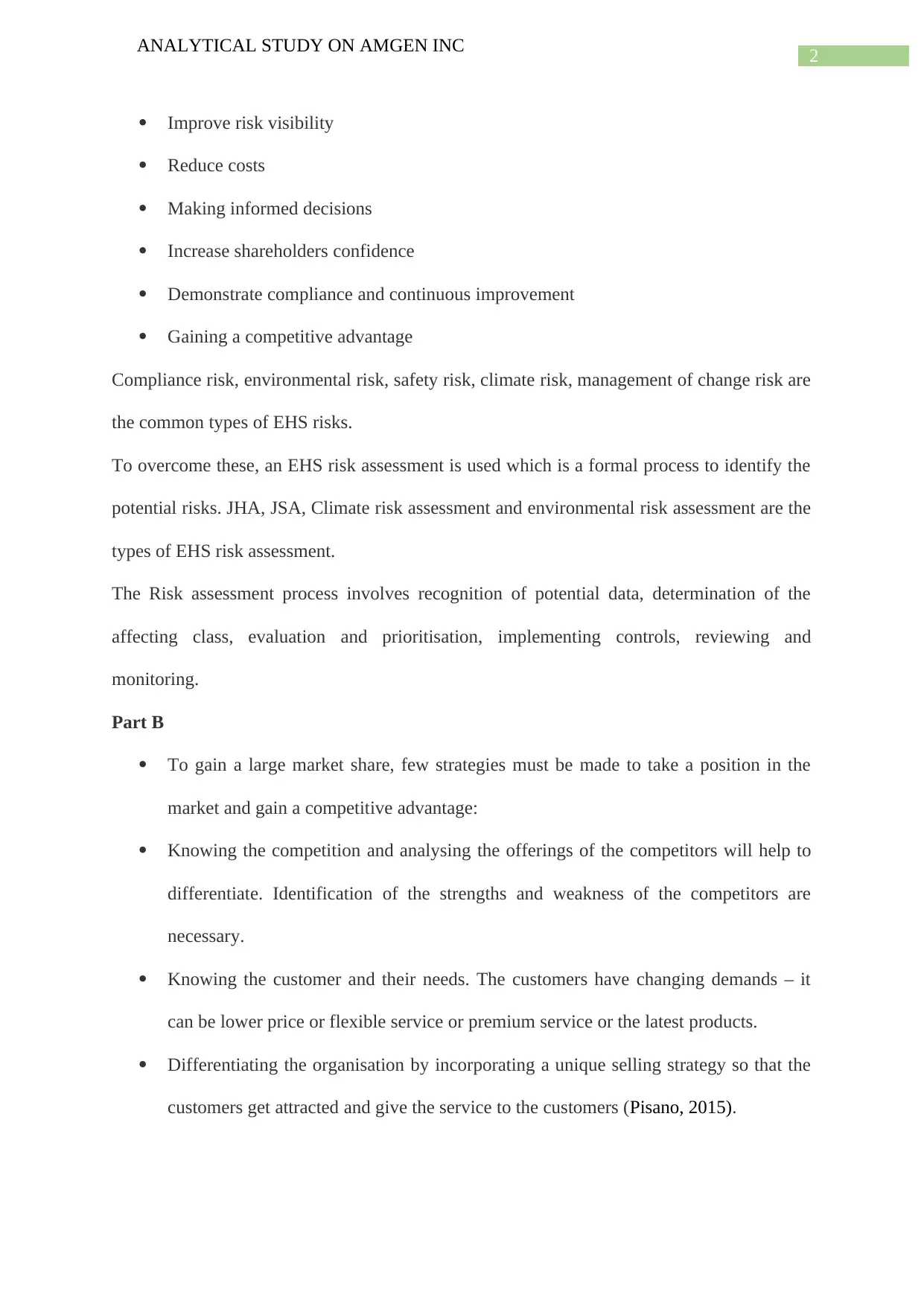
2
ANALYTICAL STUDY ON AMGEN INC
Improve risk visibility
Reduce costs
Making informed decisions
Increase shareholders confidence
Demonstrate compliance and continuous improvement
Gaining a competitive advantage
Compliance risk, environmental risk, safety risk, climate risk, management of change risk are
the common types of EHS risks.
To overcome these, an EHS risk assessment is used which is a formal process to identify the
potential risks. JHA, JSA, Climate risk assessment and environmental risk assessment are the
types of EHS risk assessment.
The Risk assessment process involves recognition of potential data, determination of the
affecting class, evaluation and prioritisation, implementing controls, reviewing and
monitoring.
Part B
To gain a large market share, few strategies must be made to take a position in the
market and gain a competitive advantage:
Knowing the competition and analysing the offerings of the competitors will help to
differentiate. Identification of the strengths and weakness of the competitors are
necessary.
Knowing the customer and their needs. The customers have changing demands – it
can be lower price or flexible service or premium service or the latest products.
Differentiating the organisation by incorporating a unique selling strategy so that the
customers get attracted and give the service to the customers (Pisano, 2015).
ANALYTICAL STUDY ON AMGEN INC
Improve risk visibility
Reduce costs
Making informed decisions
Increase shareholders confidence
Demonstrate compliance and continuous improvement
Gaining a competitive advantage
Compliance risk, environmental risk, safety risk, climate risk, management of change risk are
the common types of EHS risks.
To overcome these, an EHS risk assessment is used which is a formal process to identify the
potential risks. JHA, JSA, Climate risk assessment and environmental risk assessment are the
types of EHS risk assessment.
The Risk assessment process involves recognition of potential data, determination of the
affecting class, evaluation and prioritisation, implementing controls, reviewing and
monitoring.
Part B
To gain a large market share, few strategies must be made to take a position in the
market and gain a competitive advantage:
Knowing the competition and analysing the offerings of the competitors will help to
differentiate. Identification of the strengths and weakness of the competitors are
necessary.
Knowing the customer and their needs. The customers have changing demands – it
can be lower price or flexible service or premium service or the latest products.
Differentiating the organisation by incorporating a unique selling strategy so that the
customers get attracted and give the service to the customers (Pisano, 2015).
⊘ This is a preview!⊘
Do you want full access?
Subscribe today to unlock all pages.

Trusted by 1+ million students worldwide
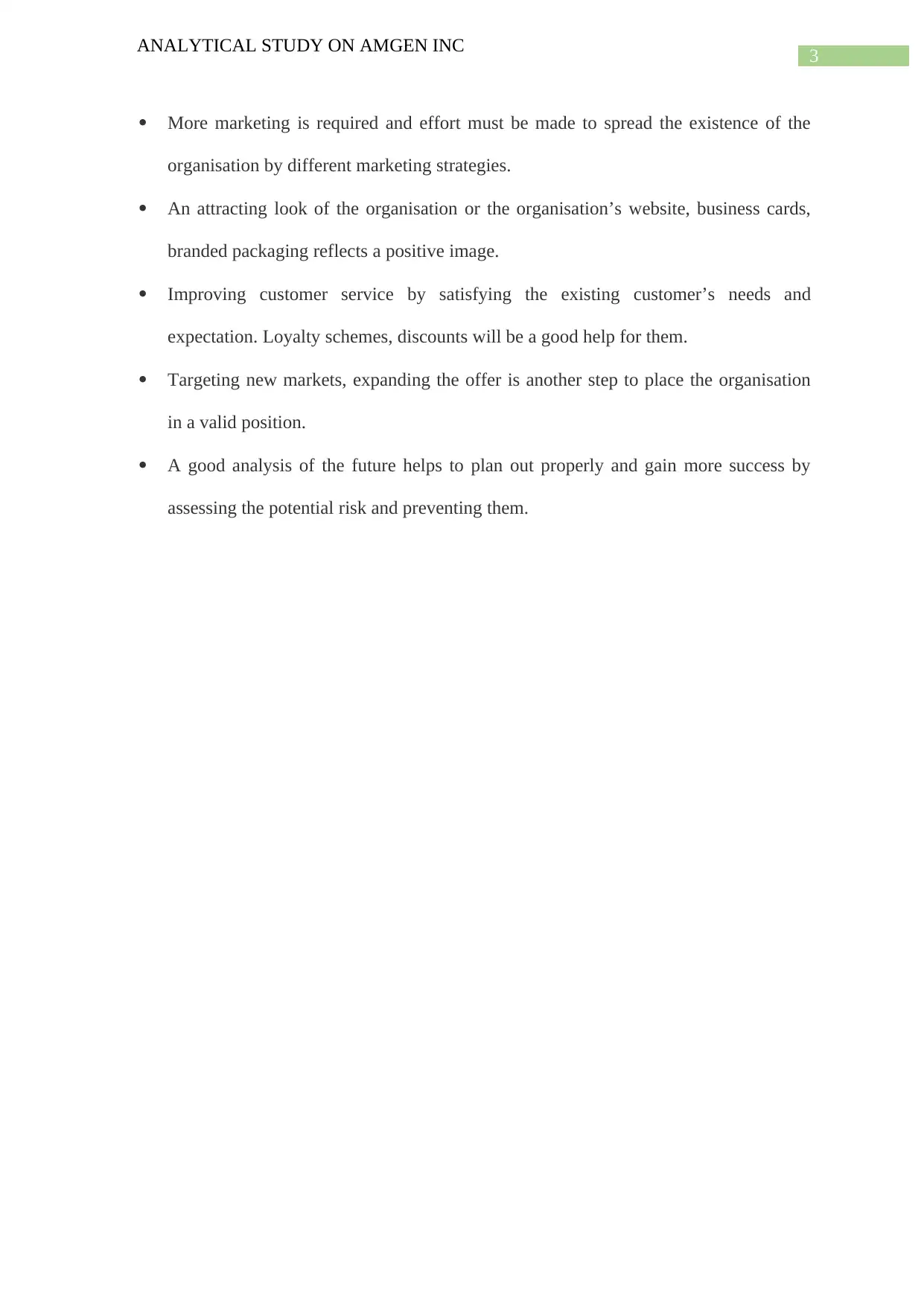
3
ANALYTICAL STUDY ON AMGEN INC
More marketing is required and effort must be made to spread the existence of the
organisation by different marketing strategies.
An attracting look of the organisation or the organisation’s website, business cards,
branded packaging reflects a positive image.
Improving customer service by satisfying the existing customer’s needs and
expectation. Loyalty schemes, discounts will be a good help for them.
Targeting new markets, expanding the offer is another step to place the organisation
in a valid position.
A good analysis of the future helps to plan out properly and gain more success by
assessing the potential risk and preventing them.
ANALYTICAL STUDY ON AMGEN INC
More marketing is required and effort must be made to spread the existence of the
organisation by different marketing strategies.
An attracting look of the organisation or the organisation’s website, business cards,
branded packaging reflects a positive image.
Improving customer service by satisfying the existing customer’s needs and
expectation. Loyalty schemes, discounts will be a good help for them.
Targeting new markets, expanding the offer is another step to place the organisation
in a valid position.
A good analysis of the future helps to plan out properly and gain more success by
assessing the potential risk and preventing them.
Paraphrase This Document
Need a fresh take? Get an instant paraphrase of this document with our AI Paraphraser
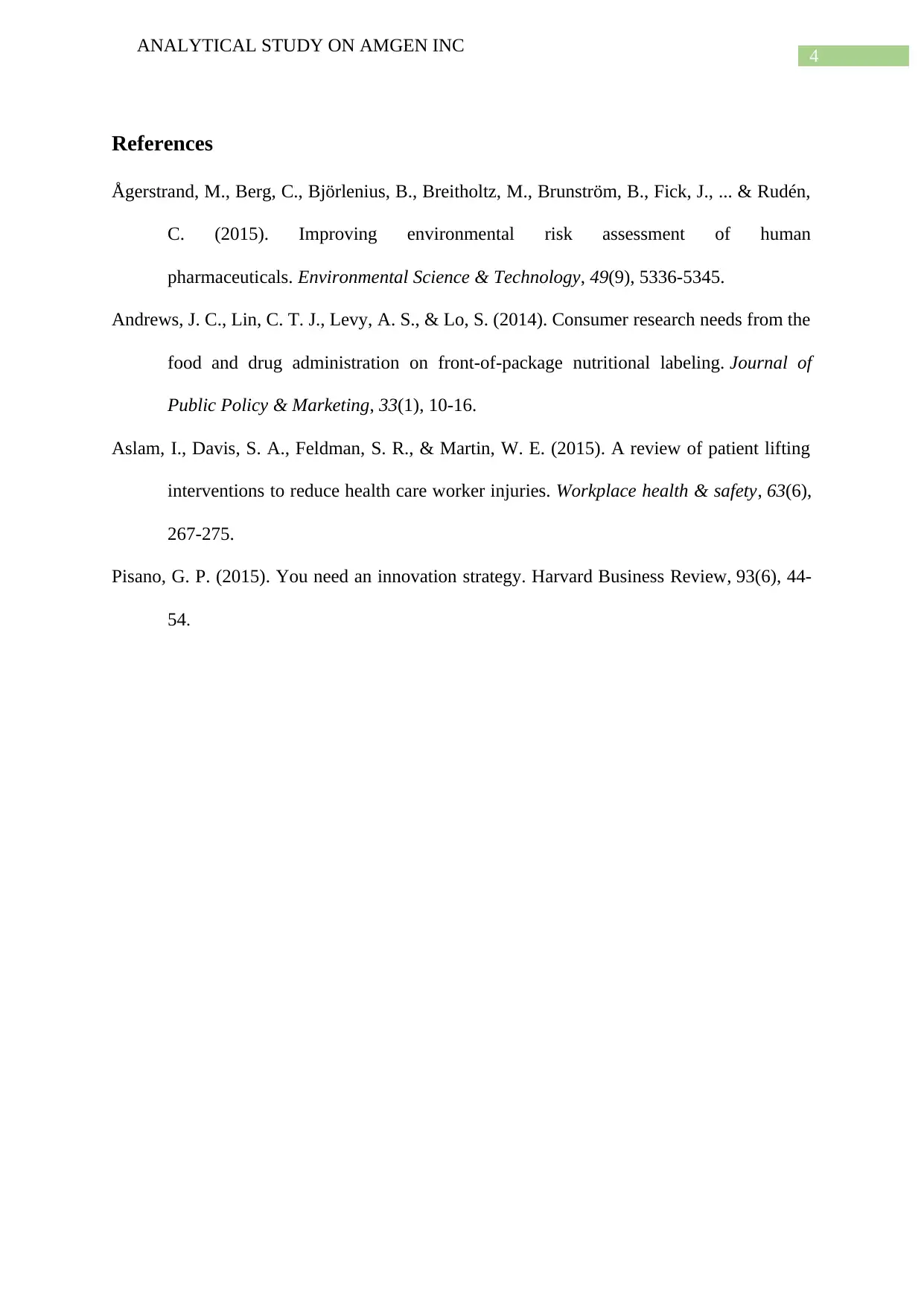
4
ANALYTICAL STUDY ON AMGEN INC
References
Ågerstrand, M., Berg, C., Björlenius, B., Breitholtz, M., Brunström, B., Fick, J., ... & Rudén,
C. (2015). Improving environmental risk assessment of human
pharmaceuticals. Environmental Science & Technology, 49(9), 5336-5345.
Andrews, J. C., Lin, C. T. J., Levy, A. S., & Lo, S. (2014). Consumer research needs from the
food and drug administration on front-of-package nutritional labeling. Journal of
Public Policy & Marketing, 33(1), 10-16.
Aslam, I., Davis, S. A., Feldman, S. R., & Martin, W. E. (2015). A review of patient lifting
interventions to reduce health care worker injuries. Workplace health & safety, 63(6),
267-275.
Pisano, G. P. (2015). You need an innovation strategy. Harvard Business Review, 93(6), 44-
54.
ANALYTICAL STUDY ON AMGEN INC
References
Ågerstrand, M., Berg, C., Björlenius, B., Breitholtz, M., Brunström, B., Fick, J., ... & Rudén,
C. (2015). Improving environmental risk assessment of human
pharmaceuticals. Environmental Science & Technology, 49(9), 5336-5345.
Andrews, J. C., Lin, C. T. J., Levy, A. S., & Lo, S. (2014). Consumer research needs from the
food and drug administration on front-of-package nutritional labeling. Journal of
Public Policy & Marketing, 33(1), 10-16.
Aslam, I., Davis, S. A., Feldman, S. R., & Martin, W. E. (2015). A review of patient lifting
interventions to reduce health care worker injuries. Workplace health & safety, 63(6),
267-275.
Pisano, G. P. (2015). You need an innovation strategy. Harvard Business Review, 93(6), 44-
54.
1 out of 5
Related Documents
Your All-in-One AI-Powered Toolkit for Academic Success.
+13062052269
info@desklib.com
Available 24*7 on WhatsApp / Email
![[object Object]](/_next/static/media/star-bottom.7253800d.svg)
Unlock your academic potential
Copyright © 2020–2025 A2Z Services. All Rights Reserved. Developed and managed by ZUCOL.





